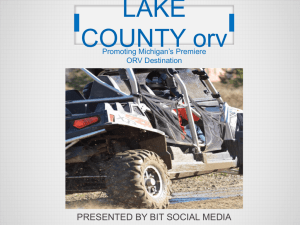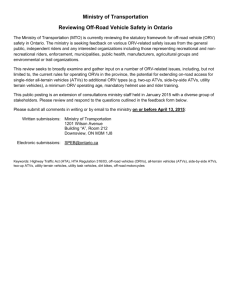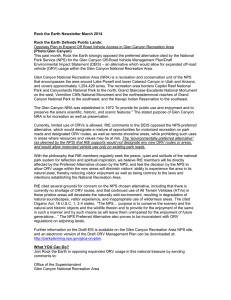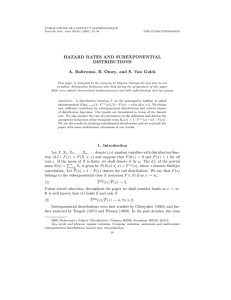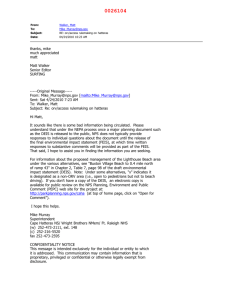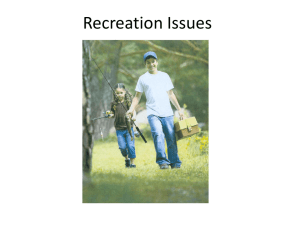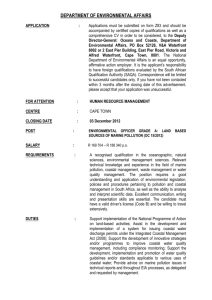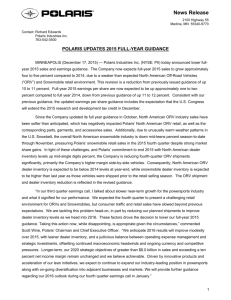The Off-Road Recreation Vehicle— Visual Impacts 1
advertisement
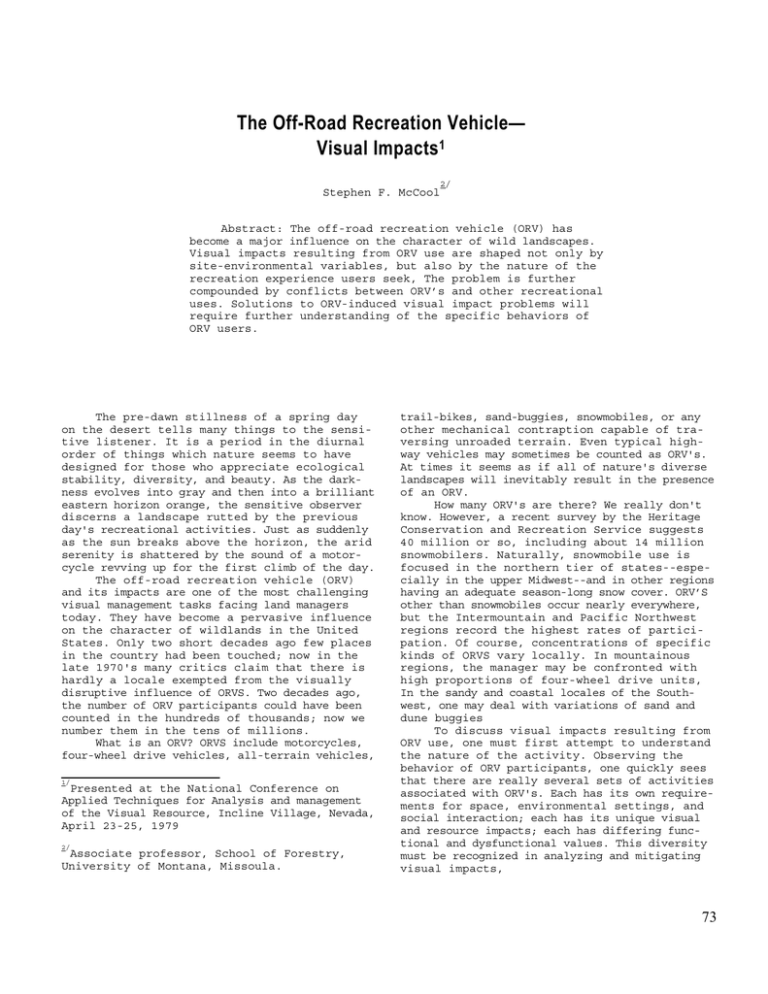
The Off-Road Recreation Vehicle— Visual Impacts1 2/ Stephen F. McCool Abstract: The off-road recreation vehicle (ORV) has become a major influence on the character of wild landscapes. Visual impacts resulting from ORV use are shaped not only by site-environmental variables, but also by the nature of the recreation experience users seek, The problem is further compounded by conflicts between ORV’s and other recreational uses. Solutions to ORV-induced visual impact problems will require further understanding of the specific behaviors of ORV users. The pre-dawn stillness of a spring day on the desert tells many things to the sensitive listener. It is a period in the diurnal order of things which nature seems to have designed for those who appreciate ecological stability, diversity, and beauty. As the darkness evolves into gray and then into a brilliant eastern horizon orange, the sensitive observer discerns a landscape rutted by the previous day's recreational activities. Just as suddenly as the sun breaks above the horizon, the arid serenity is shattered by the sound of a motorcycle revving up for the first climb of the day. The off-road recreation vehicle (ORV) and its impacts are one of the most challenging visual management tasks facing land managers today. They have become a pervasive influence on the character of wildlands in the United States. Only two short decades ago few places in the country had been touched; now in the late 1970's many critics claim that there is hardly a locale exempted from the visually disruptive influence of ORVS. Two decades ago, the number of ORV participants could have been counted in the hundreds of thousands; now we number them in the tens of millions. What is an ORV? ORVS include motorcycles, four-wheel drive vehicles, all-terrain vehicles, 1/ Presented at the National Conference on Applied Techniques for Analysis and management of the Visual Resource, Incline Village, Nevada, April 23-25, 1979 2/ Associate professor, School of Forestry, University of Montana, Missoula. trail-bikes, sand-buggies, snowmobiles, or any other mechanical contraption capable of traversing unroaded terrain. Even typical highway vehicles may sometimes be counted as ORV's. At times it seems as if all of nature's diverse landscapes will inevitably result in the presence of an ORV. How many ORV's are there? We really don't know. However, a recent survey by the Heritage Conservation and Recreation Service suggests 40 million or so, including about 14 million snowmobilers. Naturally, snowmobile use is focused in the northern tier of states--especially in the upper Midwest--and in other regions having an adequate season-long snow cover. ORV’S other than snowmobiles occur nearly everywhere, but the Intermountain and Pacific Northwest regions record the highest rates of participation. Of course, concentrations of specific kinds of ORVS vary locally. In mountainous regions, the manager may be confronted with high proportions of four-wheel drive units, In the sandy and coastal locales of the Southwest, one may deal with variations of sand and dune buggies To discuss visual impacts resulting from ORV use, one must first attempt to understand the nature of the activity. Observing the behavior of ORV participants, one quickly sees that there are really several sets of activities associated with ORV's. Each has its own requirements for space, environmental settings, and social interaction; each has its unique visual and resource impacts; each has differing functional and dysfunctional values. This diversity must be recognized in analyzing and mitigating visual impacts, 73 ORV activity includes such aspects as competition, play, exploration, and group participation. At any given time and place, an ORV participant may hold differing levels of these orientations, thus affecting the participants' behavior, and consequently impacts on the resource and conflicts with other users. Participants oriented toward competitive activity seek status and excitement. The user reaps benefits from interacting with other participants. Essential support activities include pit crews, competition administrators, information systems, health care, trophies, and so on. Much of the pre- and post-competition activity is centered on maintaining the machine and utilizing it as the attraction for social interaction. ORV play involves somewhat random movement over the landscape with no specific destination, other than the landscape, in mind. The challenge of the environment, informal recognition of status, and social interaction may be the important values. The operating efficiency of the machine may not approach the same level of significance as in competition. Supplemental recreational activities such as camping, general play, and social interaction may be critical to a "quality" ORV experience. To the individual using the ORV for exploration, the machine may be viewed principally as a means to an end. The ORV permits other kinds of recreational experiences. Status, excitement, and affiliation motives may be minimal. Appreciation of amenities and learning about nature may be more important expectations. Activities may include rockhounding, backcountry camping, exploring ghost towns and ancient Indian ruins. A final dimension typlifying much snowmobile activity in the upper Midwest relates to the user's gregariousness. This activity is characterized by large numbers of individual snowmobilers gathering together (perhaps a club) and traveling from one rural taphouse to another. Activity occurs during the evening along linear pathways that may be very close to existing transportation corridors, or along abandoned logging trails. The nature and extent of visual intrusions resulting from ORV operation is a function not only of the recreation experience but also of the site. The principal visual intrusion begins as a track or set off parallel lines imposed upon the vegetation or the surface of the soil. These lines may remain simply as lines, but with intensive use may evolve into ruts. The ruts appear, in some forms of ORV activity, as challenges to the participant, furthering use and impacts. One set of ruts in an intensive use area becomes several ruts. Many ruts used intensively may result in complete elimination of vegetation over a broad area. 74 Visual impacts from snowmobile operation are conceptually similar, The snowmobile lays down a track--a linearly compacted area--in the snow, The resulting track may attract more snowmobilers. Heavy snowmobile traffic will usually lead to the development of moguls on the trail which must either be groomed or avoided by the snowmobiler. Intensive use may result in trails 8- to 12-feet wide. However, the arrangement of the impacts is again influenced by the experience participants seek. In a competitive cross-country race, tremendous, if temporary, volumes of dust are raised at the mass start. Further down the course the landscape impact of the event may be limited to a single track, which may not be visible to the casual observer, Competitive activities which impact the landscape may involve hill climbs and drag races as well as cross-country races. Each leaves a describable impact. Contrasted to the linearly oriented impacts of a race are the broad effects of ORV play. Since movements are somewhat random, or even ordered such as in "follow-theleader" and "tag" games, multitudes of tracks gradually mingle to impact a fairly wide area. Yet, many of these impacts appear to be focused along a corridor that is determined by accessibility and spectator visibility, In some areas, a snowmobiler also engages in play. In these places, there may be many tracks spread over a broad area. The imprint of the snowmobile may not be as obtrusive as other ORVS--unless one is a crosscountry skier. Snowmobile use represents a visual, audible, and functional disruption to this group of wildland visitors. Of course, the saving factor for wildland managers is the snowstorm, If a snowfall does not completely obliterate a track, it will often soften the disrupting abruptness of the impression. Finally, in ORV exploration, impacts again are concentrated in a linear corridor. In mountainous regions much of this activity actually occurs on roads, trails, or right-ofways originally constructed for logging, grazing, mineral extraction, or some other purpose. Thus, ORV's are impacting an already impacted area. It is worth noting some behavior which extends the initial impacts of ORV's. In some competitive situations, spectators will return to the site of a cross-country race the following weekend to see if they can successfully complete the course without the competitive pressure. Spectators impact the landscape another way, too. Often, during a cross-country race, there are times of little competitive activity. Spectators, having nothing else to do, may drive their machines at random, increasing visual impacts. Pit areas and informal camping grounds are often associated with competitive events, The confused, unorganized conglomeration of vehicles results in another type of visual impact. The color and texture of campers and spectator vehicles are not congruent with the natural, free-flowing landscape they are imposed upon. Visual impacts are not necessarily limited to on-site activities or even during the same time period. These scenes indicate off-site visual impacts resulting from nearby ORV activity. The intensity of ORV visual impact varies according to use levels, type of vehicle, operation of vehicle, soil, aspect, vegetation characteristics, and season of use. Often, in arid climates, direct effects of ORV activity are compounded by wind erosion and accelerated runoff due to the reduction of soil holding vegetation. And, there may be a critical point in use levels beyond which such a compounding effect occurs, We can predict some impacts: Four-wheel drive vehicles visually disrupt an area more than three times more quickly than motorcycles. Wet season operation in some locales is a high impact period, regardless of the activity. Visual impacts on sand dunes may be obliterated by an overnight breeze while the visual intrusions left by the same vehicle in a nearby pinion-juniper stand may last endlessly. We've all heard the example of how the tracks laid down by General Patton's WWII maneuvers in the Southern California desert are still visible 30 years later. The careful observer can see traces of the Donner Party's fateful trek across the Great Salt Lake 130 years ago, Generally speaking, visual impacts last the longest in extreme environments and are self-mitigating relatively quickly in more mesic climates. Two major decisions confront the visual resource manager. First there is a siting decision, i.e., where should ORV activity he located. Beyond the very specific criteria defined in Presidential Executive Orders 11644 and 11989, the following are suggested criteria: type of experience, resource capability, visibility, residence of users, management costs, edge, and previous disturbance. The second decision concerns mitigation and rehabilitation. Essentially the manager is confronted with the "how-to" aspect of mitigating impacts after they occur and rehabilitating the site. In some areas, simple closure of the site is an acceptable and effective device, as shown in these scenes. In other situations, closures must be accompanied by additional measures such as seeding, fertilization, and watering. And in some areas even more intensive measures, such as landscape modification (terracing, filling) may be required to prevent further degradation after cessation of ORV activity. Such programs can be successful. Several years ago, a once heavily used ORV site in western Montana showed the effects of several mitigating measure: closure, seeding and landscape modification. Eighteen months later the once noticeable visual intrusion had all but disappeared. Finally, we may have to accept permanent irreversible disruption in many places such as the disturbance of desert intaglios which has already occurred or where economic feasibility of mitigation is prohibitive. These considerations raise two major issues in a discussion of visual impacts. First, what is a visual impact? Is a single set of tracks across a meadow a visual disruption? We might all agree that a large area devoid of vegetation is an impact. The essential question is: where does one draw the line? Second, if an impact is defined as a culturally induced change from the natural landscape condition, are the visual impacts left by ORV's negative or positive? I'm sure environmentalists would argue that such impacts are a detriment to the natural scheme of things. They would argue that man ought to engage in low-impact activity; they might even argue that ORV's ought to be banned because of their visual and ecological consequences. To the ORV enthusiast, however, such tracks and bared surfaces may actually be an attraction and viewed in a positive sense. The motorcyclist may see a track up the hill as the trail to follow; to the sand buggy driver, the pair of tracks ending halfway up a steep dune or hill may suggest a challenge that must be met, The ORV enthusiast may argue that many visual impacts are simply that and do not significantly impair the environment, They may argue that the traces left by their activity are no more significant than the disruption resulting from silviculture, mineral extraction, or energy production. They may even agree that such impacts are a cost, but they will point to the recreational benefits received by millions of participants. Of course, the visual impacts left by ORV's are only one part of the ORV issue, As you all well know, ORV's have become one of the most controversial wildland recreation activities in the country. Visual impacts interact with other considerations. First, many opposed to ORV’s are opposed on the basis of the values that ORV’s represent: high-impact hard technology, Second, ORV’s produce noise--the absolute amount of which varies, obviously--which is often disruptive of other recreation experiences. Third, ORV’s conflict with many types of self-propelled activities such as hiking and ski-touring. In fact, ORV management may be the most complex recreation management task facing wildland administrators, with literally hundreds of issues needing to be addressed at the national level, 75 The visual resource challenge is a great one. We need to: 1. inventory how much area is being disrupted on a national scale; 2. project future levels of participation; 3. identify the different kinds of ORV experiences; 4. assess the characteristics of ORV sites for different experiences; 5. develop environmental and landscape impact monitoring approaches and technologies; 76 6. initiate a systematic research program focusing on the above and other high priority issues. Mitigating the visual impacts of off-road recreation vehicle use probably will not eliminate the controversy centering on this land use, but it may go a long way in providing Americans with a more visually appealing landscape
